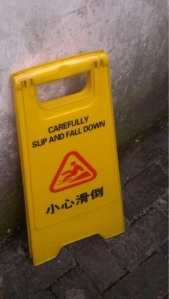Businesses are Responsible for Injuries from Misusing Caution Signs
September 27, 2016
 Kentucky Accident Information has a new post discussing how businesses are still responsible for injuries when they misuse or overuse yellow caution signs to warn of dangers on their property. The article discusses not only the misuse of yellow caution signs by businesses, but the habitual overuse of those same yellow caution signs when no danger is present.
Kentucky Accident Information has a new post discussing how businesses are still responsible for injuries when they misuse or overuse yellow caution signs to warn of dangers on their property. The article discusses not only the misuse of yellow caution signs by businesses, but the habitual overuse of those same yellow caution signs when no danger is present.
The article goes in depth to identify the most common misuse or overuse mistakes that businesses make and how they attempt to avoid liability by misusing and overusing yellow caution signs. It is a very interesting read and something every customer should keep in mind when they visit a business or commercial venue. It is important to remember that the obligation businesses owe their customers extends beyond slapping a yellow caution sign up on the property in hopes to avoid injury. Kentucky Accident Information explains the extent of that obligation and the steps customers can take to protect not only themselves but other customers as well.
Court of Appeals Clarifies Law Regarding Apportionment for Third Party Defendants.
September 7, 2016

The Kentucky Court of Appeals recently published two cases dealing with apportionment involving third-party defendants that are of interest.
In the case of Memorial Sports Complex, LLC vs. McCormick, et al, the Court was required to determine whether the dismissal, but subsequent allowance of apportionment, of the third-party defendants was appropriate. Memorial was sued after a minor (Mowery) suffered personal injury running into one of its fences during a baseball game. Memorial filed a third-party complaint, seeking contribution, indemnity, and apportionment against McCormick, (Mowery’s Coach), Mowery’s father (Dale), and Geddes Fence Company (Geddes).
The trial court granted McCormick’s and Dale’s respective motions and dismissed Memorial’s third-party claims against them with prejudice in identical judgments, stating “Due to the applicability of apportionment of fault, as required in [Kentucky Revised Statutes] KRS 411.182, there is no right to contribution” and “indemnity is not appropriate as the kind of fault alleged by Plaintiff Mowery against Memorial Sports Complex, LLC is that it created and/or maintained the hazard that was the alleged cause of Mr. Mowery’s claimed injuries.” The final judgments contained language that; “This dismissal will not prevent Third-Party Plaintiff [Memorial] from seeking an apportionment instruction relevant to the claims against it to the extent that any fault can be proved against the now
dismissed Third-Party Defendant[s][.]” Geddes moved for summary judgment which was granted by the trial court, dismissing Memorial’s claims “with prejudice, as a matter of law, subject to apportionment in Plaintiff’s [Mowery’s] claim against Memorial.” Memorial appealed both rulings.
 The Court of Appeals recently discussed what qualifies as “occupying” a car for purposes of qualifying for underinsured motorists coverage (UIM) in Jackson vs. State Farm Fire Cas. Co., unpublished. The Court discussed the four factor test to determine if someone is “occupying” a car. The Court of Appeals found as follows:
The Court of Appeals recently discussed what qualifies as “occupying” a car for purposes of qualifying for underinsured motorists coverage (UIM) in Jackson vs. State Farm Fire Cas. Co., unpublished. The Court discussed the four factor test to determine if someone is “occupying” a car. The Court of Appeals found as follows:
Considering the facts most favorably to Jackson under an expansive interpretation of the State Farm policy, we conclude the trial court erred by determining as a matter of law that Jackson was not “occupying” Doyle’s vehicle: (1) there was a causal relationship or connection between where Jackson was located when he received his injury and the use of the insured vehicle; Hayes’s action of calling to Jackson, Doyle’s action of stopping his vehicle behind Jones’s vehicle, and Jackson conversing with Hayes through the open passenger window with his back to Jones’s vehicle put him in a vulnerable position behind her vehicle and the impact of the two vehicles resulted in his injuries from being pinned
between them and hitting his head on Doyle’s vehicle; (2) Jackson was in reasonably close geographic proximity to Doyle’s vehicle because he was in actual physical contact with it when he was hit by Jones’s vehicle; (3) Jackson was vehicle oriented because he had his hands on the vehicle and was talking to Hayes through the window; and (4) Jackson was arranging a ride which was an essential transaction to enable him to use the vehicle as a passenger and, although paused, the vehicle was still being driven which is also an essential use of the vehicle. Therefore, the trial court erred in granting summary judgment to State Farm.
The Court also determined that regardless of the four factor test, Jackson qualified as “occupying” the car under State Farm’s own policy, regardless of the four part test. The Court did not believe that Jackson’s receipt of Basic Reparations Benefits from GEICO as a “pedestrian” was significant, since Jackson qualified for those benefits under State Farm’s definition of “occupying” and he could have applied for the benefits from State Farm. Finally, the purpose of the Motor Vehicle Reparations Act (MVRA) is to expand coverage, not to limit it and the four part test should not be used to limit the application of coverage, but to expand it.
A very well reasoned and fact specific application of the four part test set forth in Kentucky Farm Bureau v. McKinney, 831 S.W.2d 164 (Ky. 1992). The fact specific nature of the four part test makes it doubtful that this case will have broad application with the exception of the discussion regarding expansiveness. In the summary judgment context both the policy of insurance and the MVRA’s purpose are to be viewed as expanding coverage to persons injured in car accidents, not in limiting it. This is keeping with the summary judgment standard of “viewing the facts in the light most favorable to the non-moving party” and the MVRA’s purpose in providing a “source of recovery for injured persons.”

